

Moshi moshi?: Japan’s Influence on Mobile Phone Technology
|
Cellphones, handphones, and mobile phones -- these names all refer to the same handy device that has become ubiquitous in our daily lives. Although many of us may be familiar with a handful of smartphone brands that are currently dominating the market, did you know that Japan had a hand in spearheading and revolutionising the mobile phone market?
Between 1964 and 1972, Japan hosted several large-scale events. The 1964 Tokyo Olympics, 1970 Japan World Exposition, and 1972 Sapporo Winter Olympics were significant events that drew an influx of inbound visitors. In addition to transport and infrastructure, leaps and bounds were also made in the area of telecommunications, with Japanese company Nippon Telegraph and Telephone Public Corporation (now known as NTT) working to enable colour broadcasts of the ceremony across the world, and services that ensured high quality overseas calls. These events served as a jumping off point for more advancements in telecommunications technology in Japan. There were mobile devices available in the 1970s and 80s, such as car phones and shoulder phones but it was in the late 1980s that Japan debuted its first handheld mobile phone service. More and more people were subscribing to mobile phone services, eager to adopt the use of this revolutionary device. In 1991, the number of mobile phones in use in Japan clocked in at 1 million, but by the end of the decade, this number had well surpassed 50 million! Japan soon became giants of mobile phone technology. Japanese mobile carrier DOCOMO launched “i-mode” service in 1999. This revolutionary service allowed mobile phone users to access the Internet on their devices to exchange email messages and access exclusive websites and content. 1999 was also the year emoji were first introduced to the world. Japanese artist Shigetaka Kurita designed a set of icons to express information and add emotional subtext to messages in a succinct and simple way. This refashioned the way people communicated with each other. Emoji exploded in popularity in Japan and soon, most if not all Japanese phone companies incorporated emoji functions in their devices as well. It was only later in the 2000s that international companies too adopted the use of emoji. Soon after, new phone models with digital cameras attached were released. The popularity of these camera phones skyrocketed amongst teens and young adults as they could now attach photos and videos to their email messages to each other. The music industry also capitalised on the popularity of mobile phones, selling clips of popular songs that users could use as ringtones for incoming calls and messages. Games, movies, and manga were also made available on phones. |
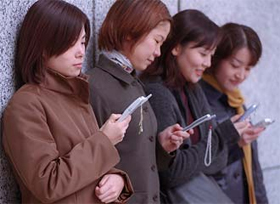 © PANA 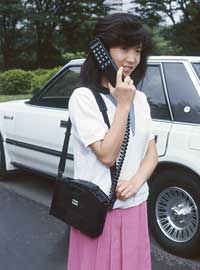 A shoulder phone © NTT DoCoMo 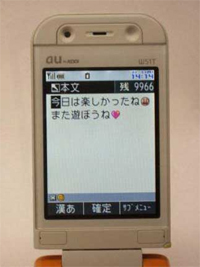 © Web Japan 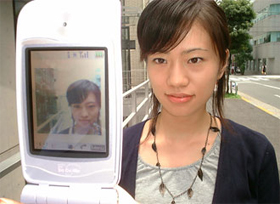 © Web Japan |
|
One unique form of mobile entertainment that took off in Japan in the 2000s was the mobile phone novels. While digitised versions of novels and manga are available, users also began writing and reading ケータイ小説 ‘keitai shosetsu’ (known as “mobile phone novels'' in English). Mobile phone novels are often multi-chaptered, with authors uploading short installments regularly to dedicated host websites. Readers can subscribe to novels they are interested in, and will receive email updates whenever there are updates. With mobile phone novels, there are little to no barriers between authors and readers; readers can leave comments and feedback on stories, and even interact directly with the author on message boards and forums. There are also few barriers for beginners to start writing novels themselves! As long as one has an idea and a cellphone, they can start sharing their stories with others.
Mobile phone novels deal with a wide variety of themes, including those that are sometimes considered a touch taboo for mainstream media. They are often written in first person, allowing readers to really immerse themselves in the melodrama of the story. Perhaps the characteristic that helps mobile phone novels stand out from traditionally published work is the use of text features like emoticons and textspeak. Authors will often use emoticons and emoji to further highlight the emotions in the particular scene. Colloquial language, slang, and texting shorthands are not limited to just dialogue, but to the text of the novel itself. These stylistic features adopted by the authors help provide economy of expression, especially at a time where phone screen space was limited. Although some more traditional publishers may not consider mobile phone novels proper literature, they have made a large impact. The wide use of cellphones and the ease of distribution have helped these novels proliferate, and some stories have reached such a level of fame that they have crossed over into print and film. One mobile phone novel that has achieved such fame is Mika’s “Love Sky.” According to statistics, it has been viewed over 12 million times online and was even advertised on television! It has even received manga, television, and film adaptations. The 2007 film adaptation in particular starred top stars Yui Aragaki and Haruma Miura in lead roles, and became one of the highest grossing Japanese films of that year. Mobile game culture also got a headstart in Japan before anywhere else in the world. By the early 2000s, mobile phone users were able to play a wide range of games on their phones. Some camera phones were even able to run 3D games with graphics comparable to that on game consoles. Mobile games soon became popular worldwide, but Japan still remains the world’s largest market for mobile games. Besides providing entertainment, phones were also increasingly equipped with functions that were practical. Tie-ups with companies like Sony have produced phone models with mobile wallet functions. People could use their phones to make purchases and pay for trips on public transport. The streamlining of these practical functions together with entertainment and communication capabilities made the lives of Japanese people convenient, even before the dawn of smartphones. So useful are these functions that they are present now on most modern smartphones. Although smaller, more compact phone models have given way to sleeker phones with larger screens, and services like i-mode have been phased out in favour of mobile data plans, the impact that Japan had on telecommunications is undeniable. Not just mobile phones, but other portable devices like tablets today have many of the functions that first appeared in the Japanese market. Inventions like emoji have also become so integrated in how people communicate worldwide. What kind of functions do you hope to see in future phones? |
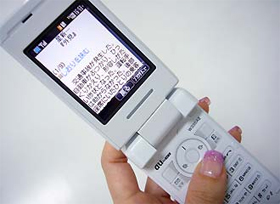 © Shinchosha 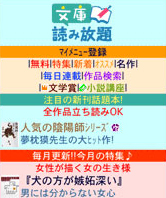 © KADOKAWA SHOTEN PUBLISHING CO., LTD., Kadokawa Digix Incorporated., BANDAI NETWORKS 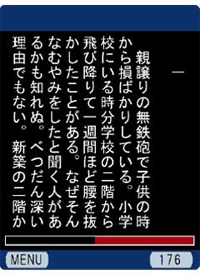 © KADOKAWA SHOTEN PUBLISHING CO., LTD., Kadokawa Digix Incorporated., BANDAI NETWORKS  © Web Japan  © Web Japan 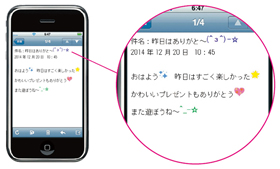 © Web Japan |
Resources
|
Corporation, N. (2017). A History of Telecommunications & the Olympics and Paralympics. Retrieved 30 April 2021, from https://www.ntt.co.jp/activity/en/2020/history/#area1964 |
|
Japan Creative Centre 4 Nassim Road, Singapore 258372 +65 6737 0434 / jcc@sn.mofa.go.jp https://www.sg.emb-japan.go.jp/JCC/ Nearest parking at Orchard Hotel & Delphi Orchard |
 |